Please join us for our May visual habitat assessment training with the LRWP and WMA9 Americorps Watershed Ambassador Katee Meckler! (Here’s more on the LRWP’s water quality monitoring programs).
This FREE training will run from 9 AM – 1 PM at the Rutgers Cooperative Extension EARTH Center at Davidson’s Mill Pond, located at 42 Riva Avenue in North Brunswick.
We will start the morning with a lecture indoors, and then get out in the field to test our knowledge of streams and stream habitat.
Please wear clothing and footwear that you don’t mind getting wet and dirty.
RSVP required, E-mail Heather: hfenyk AT lowerraritanwatershed DOT org
Water Protectors in Standing Rock, North Dakota protesting the Dakota Access Pipeline brought attention to serious flaws in the federal environmental review and approval process for crude oil and natural gas pipeline projects. The Water Protectors argued that all infrastructure projects need to include a truly comprehensive Environmental Impact Statement (EIS) that evaluates impacts to our natural and cultural assets.
While the federal oversights affecting Standing Rock were particularly egregious, the legacy of compromised Federal Energy Regulatory Commission (FERC) environmental review processes should be of concern to New Jersey residents as well. Oil and gas pipelines already fragment our environment as they crisscross the state. Our Lower Raritan Watershed may be impacted further by the proposed. This project includes a 3.4-mile-long, 26-inch-diameter pipeline loop in Middlesex County, and a 23.4-mile-long, 26-inch-diameter pipeline loop (called the “Raritan Bay Loop”) beginning at the Middlesex County coast and crossing New Jersey and New York State marine waters.
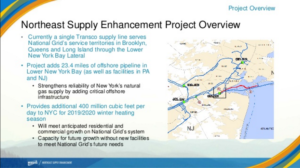
Because the Lower Raritan Watershed Partnership has concerns that the pipeline would have irreversible impacts on our communities, watershed ecology and marine habitat, we joined dozens of other concerned citizens and environmental groups at the April 20 meeting of the Middlesex County Freeholders to encourage elected officials to take action on a project that would pose significant risks. The Home News covered our public statements, and the Middlesex County Freeholder’s response.
And on April 25, the LRWP applied for intervenor status to address the Federal Energy Regulatory Commission (FERC) on the Williams/Transcontinental Application for the Northeast Supply Enhancement (NESE) Pipeline Project (Docket Number CP17-101). Becoming an intervenor provides legal standing in the proceeding, and obligates FERC to address any comments we may submit. The LRWP included the following in our application for intervenor status:
“The Transco Pipeline proposals pose significant risks to our Central New Jersey communities. These projects will solely benefit New York City markets, yet our New Jersey communities would bear significant public health and economic risks – including increased rates of leukemia, lymphomas, respiratory disorders and other diseases – while receiving little or no benefits. We must not expose our local communities to a high-risk proposition with little to no reward.
The Transco Pipeline proposals will harm our environment and the habitat of our Raritan Watershed and Raritan Bay. The building of pipeline infrastructure and the transport of natural gas from the Marcellus Shale region to New York will fragment our natural habitat, and disrupt commercial and recreational marine activities for residents and visitors. Our communities are working hard to restore landscapes destroyed by decades of industrial dumping and toxic pollution, let’s not reverse this positive trend.
The Transco Pipeline proposals are unnecessary. The Transco Pipeline would be a redundant expansion of industrial natural gas infrastructure through our Middlesex County, Somerset County and Bayshore communities. The LRWP recognizes that aging rail, bridge and other infrastructure that currently accommodates fuel transport poses risks that could lead to devastating spills in our waterways. This serious concern that can be addressed by two-pronged strategy: significant investment in the repair and maintenance of our existing infrastructure, and shifting investments to safe, clean renewable energy.
The Transco Pipeline proposals are not what our communities want. The overwhelmingly negative feedback on the project during community meetings has made it clear that this project does not have the support of community residents!”
Article and photos by Joe Sapia
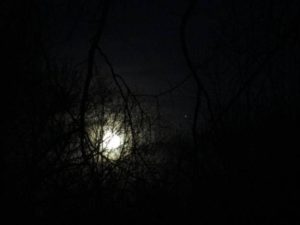
The Full Easter Moon rises over the Manalapan Brook floodplain in Monroe, Middlesex County, on the April 10-11, Monday-Tuesday, overnight. The white speck to the right of the moon is Jupiter.
Author’s note: The yard references are to my house in the section of Monroe between Helmetta and Jamesburg in South Middlesex County. My yard is in a Pine Barrens outlier on the Inner Coastal Plain, the soil is loamy, and my neighborhood is on the boundary of Gardening Zones 6b (cooler) and 7a (warmer).
FIRSTS OF THE SEASON: For the first time this season, I saw a bee, bat, and cabbage white butterfly – all on the same day, April 10. The bee was in my side yard, the cabbage white in my garden, and the bats, both flying over my yard and near woods edge at Manalapan Brook. (Also, it was the first day I heard my attic fan kick in.)

A cabbage white butterfly in my garden, near an oak leaf for a size comparison.
MULCHING TREES: Oh, no, mulch “volcanoes”! Those are the volcano-shaped mulch structures around tree trunks. Mulching is done for a variety of reasons, such as providing moisture and drainage, while serving as a buffer against yard equipment and giving the yard a neater look. But volcanoes are bad for the tree – they can lead to over-moisture and the introduction of disease. So, go for the “doughnut”: creating a doughnut-like circle around the tree, the inner circle having no contact with the tree or its roots, the outer circle 2 to 3 inches of mulch either to the end of the root ball or the tree’s drip line.
MA’S FLOWERING QUINCE: My family is the original owner of my house, going back to 1953. I was born in 1956 and never recall a time without Ma’s flowering quince bush. So, I figure the bush was planted soon after the family bought the property in ’53. This year, the flowering is not looking good, probably because of the warm weather inducing budding, followed by cold weather killing the buds.
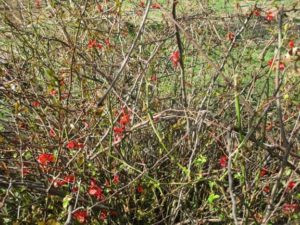
Ma’s flowering quince not looking too good this season, probably because the flowering was affected by the warm temperatures that prompting budding, followed by cold killing the buds.
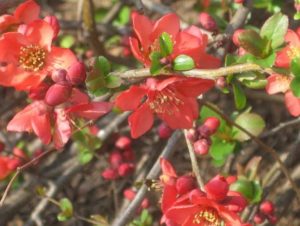
The flowering quince during a nicer bloom in spring, 2012.
FLOWERING AT “THE MASTERS” GOLF TOURNAMENT: The Masters Golf Tournament played annually in Augusta, Georgia, is known for its flowering beauty. This year, though, Augusta had a warm winter followed by cold spring days, prompting an early bloom followed by killing freezes. So, when the Masters was played April 6 to 9, the flowering was not that vibrant.
HELMETTA POND FISHING: Helmetta Pond is a typical Pine Barrens “tea water,” acidic body of water, here in the Spotswood Outlier of the Pines. Joey Slezak, my local go-to science person, fished the Pond April 12 and caught pickerel and largemouth bass.
BIRDS SINGING: Listen to the spring songs of birds, probably asserting territory or seeking mates. This week, I heard them as early as about 5:15 a.m., or more than an hour before sunrise.
SNORTING DEER: On the overnight of the full moon, I walked across the street to Manalapan Brook, spooking some deer. At least one gave out a few loud snorts, probably alerting other deer of my presence and maybe trying to spook me. The snort is sort of spooky, but something I get a kick out of, wildlife communicating because of me. Then, the deer bolted.
MA’S FLOWERS: Ma died at 81-years-old in 1995, but, come spring, her front yard daffodils and crocuses continue blooming.
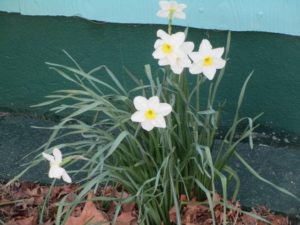
Ma’s daffodils, still blooming in the front yard, 22 years after Ma died.
MORE NATURE NEWS FROM THE JERSEY MIDLANDS: See the observations made by naturalist Bill Simmons, http://www.inaturalist.org/observations/wsimmons. Bill is the retired environmental coordinator for the Monmouth County Health Department. He also is at @BillSimmonsNJ on Twitter.com.
SUNRISE/SUNSET: For the week of April 16, Sunday, to April 22, Saturday, the sun will rise at about 6:07 to 6:15 a.m. and set at about 7:38 to 7:44 p.m.
WEATHER: Go to the National Weather Service forecasting station for the area, http://www.weather.gov/phi/.
— Joseph Sapia
2017, April 15, Easter Saturday,
Joe Sapia, 60, is a lifelong Monroe resident. He is a Pine Barrens naturalist and an organic vegetable-fruit gardener. He gardens the same backyard plot as did his Italian-American father, Joe Sr., and his Polish-immigrant, maternal grandmother, Annie Poznanski Onda. Both are inspirations for his food gardening. He draws inspiration on the local Pine Barrens from his mother, Sophie Onda Sapia, who lived her whole life in these Pines, and his Grandma Annie.
Article and photos by Joe Mish
RAINFALL: It rained about 2.5 inches in the New Brunswick-Trenton area at the end of last week. So, it will be interesting to see what this week’s drought maps say.
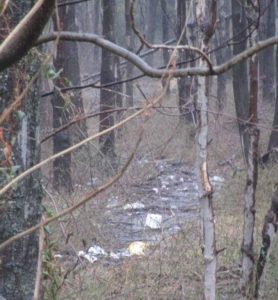
Garbage floating in a Monroe, Middlesex County, drainage ditch
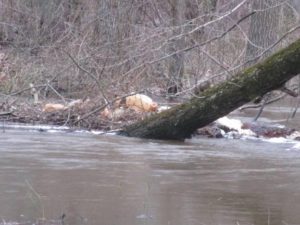
Garbage caught on a tree snag
in Manalapan Brook, Monroe, Middlesex County
NON-POINT SOURCE POLLUTION: During and after the week’s rains, the flow of non-point source pollution was obvious in our waterways. The cost-free way of dealing with it is, do not litter and do not leave stuff out in the yard, then it will not float into waterways.
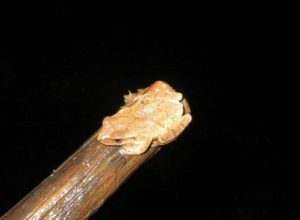
A spring peeper treefrog, found in the Manalapan Brook floodplain
FROGS: I walked into the swamp hardwood forest of the Manalapan Brook floodplain between Helmetta and Jamesburg early in the week. The sleigh bells-like sound of spring peeper treefrogs, “Pseudacris crucifer crucifer,” was obvious. I also heard monkey chattering-like sound of wood frogs, “Rana sylvatica.”
RASPBERRIES: I planted five bare-root Burpee seed company Caroline raspberry plants.
GARDEN ZONES: Depending on the source, the area is Garden Zone 6 (cooler) to Garden Zone 7 (warmer). That means our last frost generally is April 15 to 30; Our first frost is generally Oct. 11 to 20. Beyond that, I am playing it safe and sticking with Zone 6 for my Helmetta area, Middlesex County, home, although the area becoming a solid Zone 7 because of global warming is likely just around the corner.
OUTDOOR PLANTING FOR SUMMER VEGETABLES AND FRUITS: My rule of thumb is May 20 if it is a warm to normal and, if it is cooler, wait to June 1.
PREPARING PLANTS INDOOR: This year, though, I am trying something new, sowing plants indoors before the outside plant dates. So, I am experimenting with Kaleidoscope Blend Organic and Touchon carrots, Iceberg A lettuce, and Sugar Snap peas, all Burpee, which I began sowing about March 5. I added Rutgers tomatoes about March 25. I plan on sowing more tomatoes – Brandywine Red and Red Cherry, both Lake Valley brand – indoors in the next day or so.
HUMMINGBIRDS: Get the hummingbird feeders up by about April 15 to attract the early “scout” birds and they hopefully will lead later-arriving hummingbirds to the feeders.
NIGHT SKY: http://www.skyandtelescope.com/observing/sky-at-a-glance/this-weeks-sky-at-a-glance-march-31-april-8/.
SUNRISE/SUNSET: Approximate times are April 2, Sunday, 6:40 and 7:23 Eastern Daylight Time; April 3, Monday, 6:38 and 7:25; April 4, Tuesday, 6:36 and 7:26; April 5, Wednesday, 6:35 and 7:27; April 6, Thursday, 6:33 and 7:28[ April 7, Friday, 6:31 and 7:29; an April 8, Saturday, 6:30 and 7:30.
WEATHER: Local weather forecasts are available at http://www.weather.gov/phi/.

Carnegie Lake near the Kingston dam
on the boundary of Mercer, Middlesex, and Somerset counties
Joe Sapia, 60-years-old, grew up and lives in the Pine Barrens around Helmetta, where his family has resided for more than 100 years. He can be reached at Snufftin@aol.com or at P.O. Box 275, Helmetta, 08828.
Please join the LRWP, New Brunswick Environmental Commission, New Brunswick Parks & Gardens Commission, Rutgers’ Collaborative Center, and the New Jersey Chapter of the American Society of Landscape Architecture to help plant milkweed in our pollinator garden in New Brunswick’s Buccleuch Park. At this event we will focus on planting hundreds of milkweed plants started from seed by community members!
This effort is an outgrowth of the LRWP’s effort to improve habitat connectivity in our urban watershed, and we have been working on this project for 2+ years. Please plan to bring (if you have them) garden gloves, trowels and smaller hand tools, shovels and rakes, compost, watering cans. PLEASE LABEL YOUR TOOLS!
We will be working across from the gazebo next to the wood chips in Buccleuch Park (321 Easton Ave, New Brunswick, NJ 08901) from 10-noon.
At our May 15 meeting we will welcome Raritan Scholar interns, Rutgers Environmental Stewards, and LRWP volunteers to highlight their work on a diverse set of projects including a virtual tour of the Lower Raritan Watershed, a Story Map of Highland Park’s Mill Brook, NASA’s Soil Moisture Active Passive program in the Lower Raritan Watershed, and more.
The meeting will be held from 10-noon in the Middlesex County Planning Offices at 75 Bayard Street, New Brunswick, NJ – 5th floor mid-size conference room.
Parking is validated for those parking on floors 5 and higher in the RWJ Wellness Parking Deck located at 95 Paterson Street, New Brunswick, NJ 08901. Be sure to bring your ticket to the meeting for validation.
For more information contact Heather: hfenyk AT lowerraritanwatershed DOT org
Our April 17 meeting will focus on stormwater management, and will include a discussion of regional approaches to stormwater management.
The agenda will include an overview of federal expectations with respect to MS4 requirements, with Matt Klewin (NJDEP) presenting on “Update on Changes in the New MS4 Revision”. Manville Borough Administrator Andrea Bierwirth will speak about challenges to meeting MS4 requirements in the upper portion of the watershed.
The meeting will be held from 10-noon in the Middlesex County Planning Offices at 75 Bayard Street, New Brunswick, NJ – 5th floor mid-size conference room.
Parking is validated for those parking on floors 5 and higher in the RWJ Wellness Parking Deck located at 95 Paterson Street, New Brunswick, NJ 08901. Be sure to bring your ticket to the meeting for validation.
For more information contact Heather: hfenyk AT lowerraritanwatershed DOT org
Article by LRWP Board President Heather Fenyk
Wikipedia tells us that civic science or citizen science (CS; also known as crowd science, crowd-sourced science, volunteer monitoring or networked science) is “scientific research conducted, in whole or in part, by amateur (or nonprofessional) scientists. Citizen science is sometimes described as public participation in scientific research, participatory monitoring and participatory action research.”
The LRWP employs civic science to better understand the health of our watershed. Our volunteers engage in activities like water quality monitoring, soil sampling, pollinator counts and mapping of invasive and threatened/endangered species. The data our volunteers generate is a key input to our analyses and restoration prioritization.
While the LRWP’s mission centers on protecting, preserving and restoring habitat and biodiversity within our Lower Raritan Watershed, our civic science approach to data gathering speaks to another core purpose: by training community volunteers to monitor and report on the health of the environment we work to ensure that science, community engagement and environmental stewardship become a permanent part of the culture and identity of the Lower Raritan Watershed.
Want to learn more about citizen/civic science? Not only how it is used to characterize the health of our watersheds, track climate change and map oil spills, but also how it can improve emergency responses, help us understand how diseases spread, and keep our drinking water clean? Check out the new PBS mini-series sponsored by The Crowd and The Cloud. For a month of Thursdays this April, PBS will host a 4-part television series exploring citizen science, crowdsourcing, and mobile technology. Below we summarize the episodes in the series:
Even Big Data Starts Small
The crowd, using mobile tech, and the cloud contribute to science that saves lives. In this episode, you’ll hear stories of everyday people contributing data used for emergency management, researching Alzheimers, mapping oils spills, and more.
World Broadcast: April 6th at 9pm EST
(replayed at 9pm PST)
Citizens + Scientists
Citizen scientists track air pollution in Wyoming, test for lead in Philadelphia’s drinking water, fish for data in coldwater trout streams and report environmental crimes in China, using the “Black & Smelly Rivers” app. Hear all these stories and more in Episode 2.
World Broadcast: April 13th at 9pm EST
(replayed at 9pm PST)
Viral vs Virus
Real-time data helps track environmental triggers for asthma sufferers and citizens confront air pollution and rising asthma rates by collecting real time data. In this episode, explore how maps and apps can combat globalized disease from asthma to Zika.
World Broadcast: April 20th at 9pm EST
(replayed at 9pm PST)
Citizens4Earth
This episode explores a Year in the Life of Citizen Science. Counting birds with an app, surfers collecting ocean data while they ride the waves, volunteers surveying horseshoe crabs on the Delaware Bay, and butterflies wintering over in California.
World Broadcast: April 27th at 9pm EST
(replayed at 9pm PST)
Article and photos by Joseph Sapia
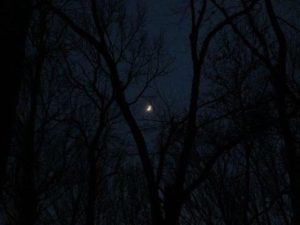
Above the Manalapan Brook floodplain, a crescent moon waxed toward December’s Full Long Nights Moon

Christmastime in Fair Haven, Monmouth County
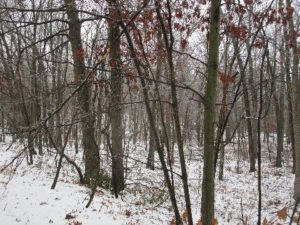
Snowfall of 1-1/2 inches December 17 in the Jamesburg Park Conservation Area, Middlesex County
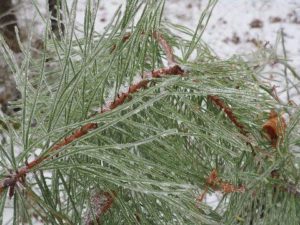
Ice builds up on the needles of a pitch pine, Pinus rigida, the common tree of the New Jersey Pine Barrens. Here, in the Jamesburg Park Conservation Area in the Pine Barrens around Helmetta.

Christmastime at historic Longstreet Farm, the Monmouth County Park System’s living history farm, replicating the late 1800s in Holmdel. Here, baking cookies the old-fashioned way.
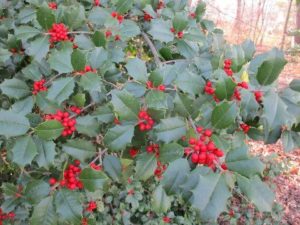
Holly in my neigbhorhood in Monroe, Middlesex County.
Joe Sapia, 60-years-old, grew up and lives in the Pine Barrens around Helmetta, where his family has resided for more than 100 years. He can be reached at Snufftin@aol.com or at P.O. Box 275, Helmetta, 08828.
Article and photos by Joe Mish

A juvenile myrtle warbler searches the ice shrouded shoreline of the South Branch in late February
February is midwinter’s better half, given it is two days shorter than any other month and two days closer to spring, a virtual, ‘get out of winter free, card’. The significance of those two missing days provides a powerful psychological boost to soothe winter doldrums and seasonal affective disorder accumulating since December.
Although spring is the ‘finish line’ for surviving winter, the early days of spring are often indistinguishable from winter weather. This demonstrates that our characterization of the seasons is based more on legend than reality, especially when a lingering winter feels like an eternity.
Moving from impressionable feelings and missing days to more tangible evidence, February provides many visual clues that spring is around the corner. Its 28 days are a prelude or appetizer, stirring the emotions, building anticipation for the main event, the first day of spring.
To see visual clues we need light and light is what February delivers. In 28 short days we gain about an hour of day length, most evident to causal observers by noting the later time of sunset.
The increasing day length triggers a response in people and animals as we see the start of bird migration, courtship, flowers and tree buds.
Bird migration is one of the most colorful visual cues that winter has run its course. The milder the winter the earlier migration begins. Migration may be local, as with bluebirds or two thousand of miles away for many of the colorful warblers.
Late February usually marks the very beginnings of small bird migration north. Our rivers, streams coastlines and even interstate roadways provide linear pathways for migrating birds. The most colorful and plentiful are the myriad of warbler varieties. It is not unusual to see a bright flash of color darting along the riverside in late February despite shoreline ice and cold weather. A band of north bound travelers may find temporary shelter during a cold spell on south facing hillsides or in brush along steep river banks, protected from the wind and saturated with full sun.
Hawks are usually seen now in pairs as they bond prior to nesting. The owls hooting on cold winter nights and local bald eagles may well be incubating eggs.
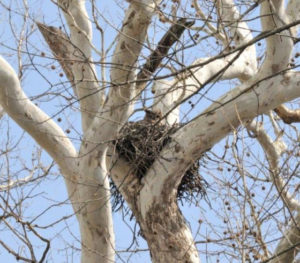
Great horned owl nesting in am old red tailed hawk nest
Muskrat, mink and fox are out and about in a courting mood. This is the time to scan fields for red fox roaming the countryside looking for mates. Love is definitely in the air.
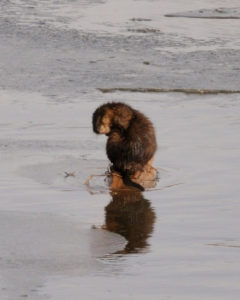
Muskrats are more often seen during their late winter early/ spring courting season
Male white-tailed deer have dropped their antlers and females are heavy with fawns as day length triggers hormonal changes to alter behavior and ensure best chances for winter survival. Now is a good time to walk the fields and woodlots to look for dropped antlers.
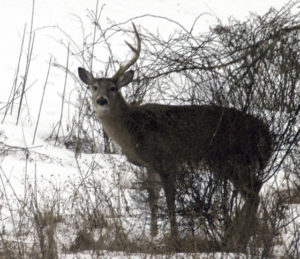
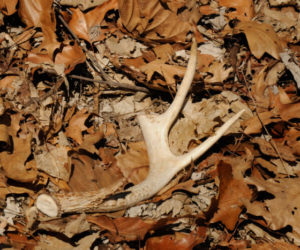
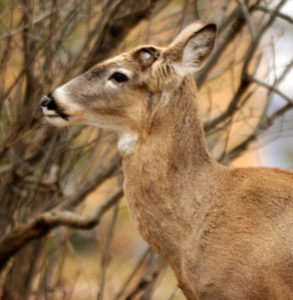
A buck has dropped one antler, the other will soon drop perhaps when it jumps a fence. A dropped antler charcterized by an irregular base. Antler buds after the antlers drop. Within a couple of months, the antlers will begin to sprout from these buds surrounded by viable tissue with a velvety appearance that readily bleeds if injured.

The first and most consistent sign of spring for me is the blooming of snowdrops, en masse on a hillside, near where I usually launch my canoe on the South Branch. As cold as it might be, the sight of those tiny white flowers gives me inspiration, fires my energy and issues a solemn promise of the return of spring.
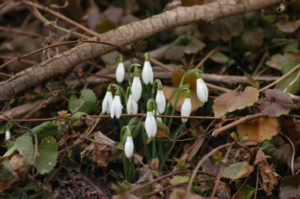
A patch of snow drops blooming midwinter heralds the return of spring
By February, the deep red leaf buds, on the trees that line the river, stand out against brown and gray interlaced branches. When viewed at a distance, the contrasting colors are enhanced as they take on a solid appearance as if created by long horizontal brush strokes in a painting.
A full moon will occur on February 11th to light up the night, as a compliment to the lengthening daylight, to make February a well lit marquee announcing next month’s arrival of spring.
Author Joe Mish has been running wild in New Jersey since childhood when he found ways to escape his mother’s watchful eyes. He continues to trek the swamps, rivers and thickets seeking to share, with the residents and visitors, all of the state’s natural beauty hidden within full view. To read more of his writing and view more of his gorgeous photographs visit Winter Bear Rising, his wordpress blog. Joe’s series “Nature on the Raritan, Hidden in Plain View” runs monthly as part of the LRWP “Voices of the Watershed” series. Writing and photos used with permission from the author.
























